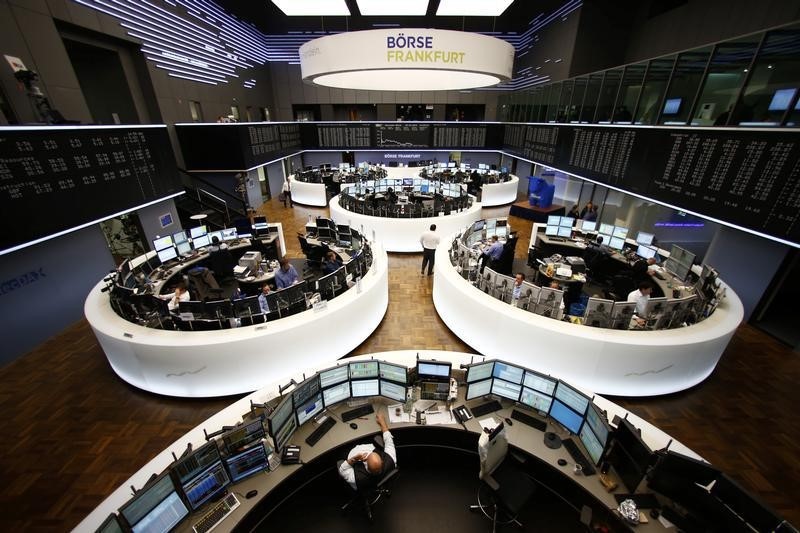* Dollar tops 107 yen, at nine-month peak against currency basket
* Treasury yields highest since Jan on inflation, supply risks
* European shares, Nikkei jump, but Asia shares ex-Japan skid
* Industrial metals extend bull run, oil goes flat
* NZ dollar slips as earthquakes rock country
By Marc Jones
LONDON, Nov 14 (Reuters) - The U.S. dollar hit an 11-month peak on Monday as the risk of faster domestic inflation and wider budget deficits if Donald Trump goes on a U.S. spending binge sent Treasury and other benchmark global bond yields ever higher.
It was a painful mix for assets in many emerging market countries. Currencies from the Mexican peso to the Malaysian ringgit fell to new lows, but for European share markets it made for a strong start to the week.
The pan-European STOXX 600 .STOXX index rose 1.1 percent, underpinned by gains among banks on hopes higher interest rates will help their profits and mining companies, which have been cheering Trump's promise of major infrastructure spending. .EU
The reflation trade also saw futures for the S&P 500 ESc1 and Dow Jones industrial 1YMc1 add another 0.5 percent after the Dow chalked up best week in five years last week. .N
The dollar bounded towards 108 yen JPY= and hit the eye-catching 100 threshold against a basket of currencies .DXY in brisk trade. That took the pace off a resurgent sterling and saw the euro slide to its lowest since the start of the year at around $1.0745 EUR= .
"Clearly the market has settled on a 'buy dollar' theme on the basis there will be a debt-fuelled U.S. fiscal binge that will push up inflation," said TD Securities European Head of Currency Strategy Ned Rumpeltin.
"People are repricing the Fed on the basis of that so it all seems to be a relatively straight forward."
The dollar has been on a tear since the victory of Republican Trump in the U.S. presidential election on Nov. 8 triggered a massive sell-off in Treasuries.
Yields on the U.S. 10-year Treasury notes climbed to their highest since January on Monday at 2.22 percent US10YT=RR , while 30-year paper reached 3 percent. German 30-year yields topped 1 percent for the first time in more than six months. GVD/EUR
Just two days of selling last week wiped out more than $1 trillion across global bond markets, the worst rout in nearly a year and a half, according to Bank of America Merrill Lynch (NYSE:BAC).
The jump in yields on safe-haven U.S. debt threatened to suck funds out of emerging markets, while the risk of a trade war between the United States and China is also causing jitters.
"There are signs that higher bond yields and the knock of a stronger US dollar are having a domino impact, taking down the weakest risky assets first, before moving on to the next," said Alan Ruskin, global co-head of forex at Deutsche.
"There is only so much financial conditions tightening that risky assets can take when fiscal stimulus is still 'a promise' that lies some way in the future."
The stampede from bonds has seen 30-year yields post their biggest weekly increase since January 2009.
SUBMERGING MARKETS
Mexico's peso MXN= , Turkey's Lira TRY= and South Africa's rand ZAR= all remained in the firing line in European trading. Emerging market stocks also extended their post- U.S. election slump to over 7 percent EMRG/FRX .
MSCI's broadest index of Asia-Pacific shares outside Japan .MIAPJ0000PUS ended at its lowest since mid-July as Hong Kong and Indonesia led the region's losses with drops of 2.7 and 2.2 percent .JKSE .
In contrast, Japan's Nikkei .N225 jumped 1.7 percent on the weakening yen to reach its highest in nine months.
It got an added fillip from data showing Japan's economy grew at an annualised rate of 2.2 percent in the third quarter, handily beating forecasts. the New Zealand dollar eased after a powerful earthquake rocked the island nation early on Monday, killing at least two people and prompting a tsunami warning that sent thousands fleeing to higher ground.
The currency dipped to $0.7092 NZD=D4 , with losses limited by talk rebuilding work would support an already strong economy and lessen the need for further interest rate cuts.
Egypt's pound EGP= strengthened, meanwhile, after the International Monetary Fund approved a $12 billion, three-year loan programme the government hopes will help restore investor confidence and stabilise the currency and economy commodities, the rampant U.S. dollar pressured gold, which lost 0.8 percent to $1,215 an ounce. Yet industrial metals extended their bull run, with copper adding 1.2 percent CMCU3 .
In the oil market, Brent crude LCOc1 dipped a few cents to $44.62 a barrel, while U.S. crude CLc1 eased 7 cents to $43.34. O/R
One market rate, measuring expected inflation over the five-year period that begins five years from today, shot up 30 basis points to 2.46 percent USIL5YF5Y=R last week, the highest since late 2014. It had been as low as 1.84 percent in June.
Fed fund futures 0#FF: in turn imply a better-than-70 percent probability the Fed will hike rates in December.
Speaking in Frankfurt, European Central Bank Vice President Vitor Constancio warned about the uncertainty being caused by the sudden swing in markets.
"We should be cautious in drawing hasty, positive conclusions from those market developments because they may not necessarily indicate that the world economy will have an accelerating recovery with higher growth," Constancio said.
